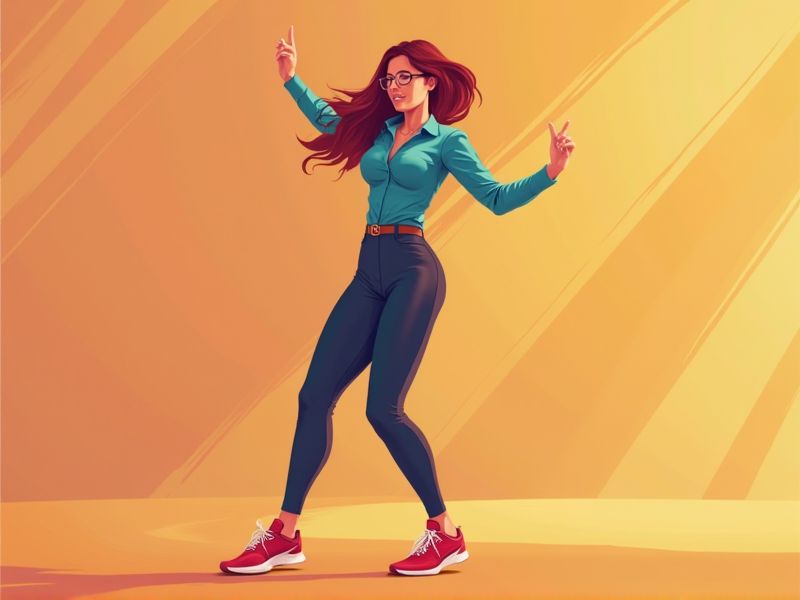
Martha Graham emphasizes the importance of practice in improving dance skills, stating, "I believe that we learn by practice. Whether it means to learn to dance by practicing dancing or to learn to live by practicing living, the principles are the same" . This highlights that consistent practice is crucial for mastering dance techniques and expressing oneself fully through movement. By dedicating time to practice, dancers can refine their skills and achieve a deeper connection with their art form. Graham's approach underscores the value of repetition and dedication in the pursuit of excellence in dance.
How to Be Better at Dancing
Consistent practice
Consistent practice reinforces muscle memory, allowing smoother transitions between dance moves. Regular training sessions help refine technique through repetition, making complex choreography more accessible. A structured routine builds both strength and endurance, reducing the risk of injury during performances. Many dancers experience marked improvement over time when they commit to a consistent practice schedule, as data shows that habitual training correlates with enhanced performance and confidence.
Core strength
Strengthening your core enhances balance and stability, which are crucial for executing precise dance moves. A robust midsection supports your entire body, allowing for improved posture and fluid transitions on the dance floor. As your core develops, you reduce the likelihood of strain or injury during complex routines, enabling longer and more effective practice sessions. Incorporating targeted exercises like planks and Pilates into your training leads to measurable improvements in both movement control and overall dancing technique.
Flexibility training
Flexibility training enhances the range of motion needed to perform smooth and dynamic dance moves. Daily stretching routines reduce muscle stiffness and lower the risk of injuries during intense practice sessions. Incorporating both dynamic warm-ups and static cool-downs prepares your muscles for rapid changes in direction and improves overall body control. Consistent flexibility work leads to improved balance, technique, and endurance, ultimately elevating your dance performance.
Rhythm development
Rhythm development is foundational because it helps to transform isolated moves into a cohesive, flowing performance. Focusing on exercises like clapping or using a metronome can train your body to internalize consistent beats. Regular practice with different genres of music exposes you to varying tempos and patterns, improving your adaptability on the dance floor. Tracking your progress with timed exercises and recording sessions often provides measurable data that reflects your rhythmic enhancement over time.
Posture alignment
Posture alignment is critical for dancing because it lays the foundation for precise movement and balance. Keeping your shoulders relaxed, back straight, and core engaged enhances your ability to control every step and turn. Regularly practicing posture exercises such as yoga or Pilates can improve your muscle memory, resulting in smoother transitions and increased stability on the dance floor. Observing your form in a mirror or recording your practice sessions provides valuable feedback that guides targeted improvements and accelerates your learning.
Balance improvement
Enhancing your balance establishes a strong foundation for improved dance performance. Incorporating core-strengthening exercises, such as planks and yoga, directly supports stability during intricate moves. Focusing on maintaining proper posture helps distribute your weight evenly, which in turn minimizes missteps and enhances fluidity. Consistent practice with balance drills progressively builds control, translating into more confident and graceful dance routines.
Technique refinement
Sharper technique starts with detailed observation--using video recordings exposes subtle movement flaws that hinder performance. Focused repetition of precise steps produces measurable improvements in spatial awareness and motor control. Real-time feedback from experienced instructors or peers accelerates corrective adjustments, reinforcing proper form. Regular incorporation of targeted drills reinforces muscle memory, resulting in enhanced technical proficiency over time.
Creative expression
Allow your emotions to guide your movements by experimenting with various dance styles to find what resonates with your personal energy. Incorporate improvisation into your routine, letting each step be a spontaneous expression of your unique rhythm. Cultivate a mindset that views mistakes as creative opportunities, using them to refine your style and push artistic boundaries. Embrace experimentation by blending traditional techniques with innovative moves, transforming dance into a dynamic dialogue between your body and the music.
Constructive feedback
Start by mastering the fundamentals through consistent practice and focused exercises that enhance balance and rhythm. Regularly seek feedback from experienced dancers or instructors who can pinpoint specific areas for improvement. Incorporating video recordings into your practice can also help you critically analyze your movements and monitor your progress. Embracing constructive criticism and adapting your technique over time will build confidence and lead to noticeable improvements on the dance floor.
Passionate enjoyment
Immerse yourself fully in the music and let your emotions drive every move, as genuine passion naturally enhances technique. Regular practice paired with experimentation across various dance styles helps you discover the movement that resonates best with your inner joy. Break down routines into simple steps and gradually layer complexity, allowing your enthusiasm and understanding of the rhythm to build steadily. Focusing on passionate enjoyment transforms dancing from mere physical exercise into an expressive art form, boosting both your skills and creative confidence.
Summary
Consistent practice is essential for refining dance techniques and reinforcing muscle memory over time. Building core strength provides stability and balance, which are critical for executing complex dance movements. Flexibility training expands the range of motion and reduces the risk of injury, allowing for smoother transitions and more dynamic performances. Combining these elements creates a comprehensive approach that enhances both technical skill and artistic expression in dancing.
